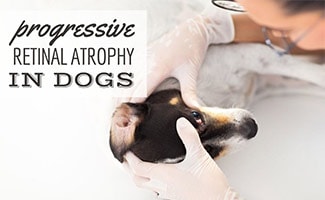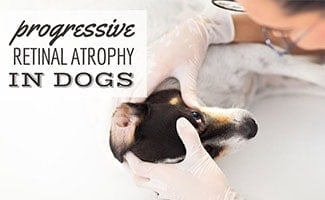
 Is your dog showing signs of vision loss? One cause could be a hereditary disease called progressive retinal atrophy (PRA), which is a common cause of blindness in purebred dogs and some mixed breeds. What is PRA in dogs? Is your pup more prone to developing this inherited disease? And how do you know if your dog is at risk?
Is your dog showing signs of vision loss? One cause could be a hereditary disease called progressive retinal atrophy (PRA), which is a common cause of blindness in purebred dogs and some mixed breeds. What is PRA in dogs? Is your pup more prone to developing this inherited disease? And how do you know if your dog is at risk?
Article Overview
Contents
What Is PRA In Dogs?
 Progressive retinal atrophy is an inherited retinal disease in dogs that causes slowly progressive blindness. How does PRA cause retinal problems in dogs? The disease slowly degenerates the photoreceptor cells (both rod and cone cells) in the retina.
Progressive retinal atrophy is an inherited retinal disease in dogs that causes slowly progressive blindness. How does PRA cause retinal problems in dogs? The disease slowly degenerates the photoreceptor cells (both rod and cone cells) in the retina.
There are several different forms of the disease that result from genetic mutations among different breeds. While all are a form of PRA, some variants are called generalized progressive retinal atrophy, progressive rod-cone degeneration, and cone-rod dystrophy.
Nearly all affected breeds inherit PRA as an autosomal recessive trait, meaning that the dogs must inherit the mutated gene from both parents. The exceptions are Bullmastiffs and Old English Mastiffs who inherit it as an autosomal dominant trait (from one parent) and Siberian Huskies and Samoyeds (inherited as an X chromosome-linked trait in male dogs).
Which Breeds Are Predisposed To PRA?
 Several studies have found genetic mutation links to the following breeds that are more prone to developing the different forms of PRA. Some of these breeds include:
Several studies have found genetic mutation links to the following breeds that are more prone to developing the different forms of PRA. Some of these breeds include:
- Basenji
- Bedlington Terriers
- Belgian Sheepdogs
- Bullmastiffs
- Cavalier King Charles Spaniels
- Cocker Spaniels (American and English)
- Collies
- Dachshunds
- English Springer Spaniels
- Golden Retrievers
- Irish Setters
- Italian Greyhounds
- Labrador Retrievers
- Lhasa Apsos
- Norwegian Elkhounds
- Old English Mastiffs
- Papillons
- Poodles (Miniature and Toy)
- Rottweilers
- Samoyeds
- Schnauzers (Miniature and Giant)
- Shetland Sheepdogs
- Siberian Huskies
- Sloughis
- Swedish Vallhunds
Will My Dog Develop PRA?
As we said above, researchers have identified several genetic mutations as major risk factors for developing PRA, so doing a DNA test on your dog can shed light on whether he has one of these genetic mutations.
 We recommend several at-home DNA test kits that can identify PRA mutations: EasyDNA, Embark, and Wisdom Panel. You can find a complete list of the PRA variant tests each company offers on their website, as well as all the other health conditions they test for. See our reviews of the best dog DNA tests to see how these companies compare and what else you can learn about your dog through a DNA test.
We recommend several at-home DNA test kits that can identify PRA mutations: EasyDNA, Embark, and Wisdom Panel. You can find a complete list of the PRA variant tests each company offers on their website, as well as all the other health conditions they test for. See our reviews of the best dog DNA tests to see how these companies compare and what else you can learn about your dog through a DNA test.
Keep in mind that if your dog has the mutation, it doesn’t mean that he’ll definitely develop PRA. It just means he’s at a higher risk. But this knowledge can help your veterinarian determine a more accurate diagnosis if your dog begins showing early symptoms.
PRA Symptoms In Dogs
- Night blindness in both eyes (typically the first sign)
- Bumping into objects in low light
- Very reflective eyes when light shines on them
- Pupils more dilated than normal
- Eventual total blindness
How Do You Know If Your Dog Is Going Blind?
 Some signs of vision loss are obvious, like your dog bumping into walls or objects or not finding his toys. But earlier signs can be harder to spot. You may notice that your pup isn’t always making eye contact with you. He may start to show reluctance to walk up or down the stairs or jump off the couch. He may also show signs of anxiety or wanting to be by your side all the time. If you notice these signs, it’s time to visit your veterinarian to determine exactly what’s going on with your pup.
Some signs of vision loss are obvious, like your dog bumping into walls or objects or not finding his toys. But earlier signs can be harder to spot. You may notice that your pup isn’t always making eye contact with you. He may start to show reluctance to walk up or down the stairs or jump off the couch. He may also show signs of anxiety or wanting to be by your side all the time. If you notice these signs, it’s time to visit your veterinarian to determine exactly what’s going on with your pup.
When & How Fast Does PRA Develop?
It depends on the breed and the form of PRA. Clinical signs can begin as early as one year old in some breeds, including Belgian Sheepdogs, Collies, Irish Setters, Norwegian Elkhounds, and Miniature Schnauzers. Other breeds don’t show signs until three to five years old or even later.
Some of these breeds include Labrador Retrievers, American and English Cocker Spaniels, Miniature and Toy Poodles, Papillons, English Springer Spaniels, Miniature Longhaired Dachshunds, and others.1 In most cases, dogs with PRA completely lose their vision over the span of one to two years.
Diagnosis
If your dog appears to be experiencing vision loss, it’s important to take him to your veterinarian. Your vet will examine each eye to look for dilated pupils, slow pupillary response to light, changes in the retinal blood vessels, and other signs.
If your vet suspects PRA, he may refer you to a veterinary ophthalmologist who will perform a progressive retinal atrophy test called an electroretinogram (ERG). The ERG measures the electrical response of retinal cells, which can help rule out other causes of vision loss and confirm PRA. They may also order genetic testing.
Progressive Retinal Atrophy Treatment

Unfortunately, there’s no treatment for PRA. However, you can make adjustments in your daily life to manage your pup’s vision loss and eventual blindness. Dogs can remember the layout of your home and your yard and will be able to maneuver by memory. However, we have some tips that can help you assist your blind pup.
- Fence off dangerous areas like stairs, a balcony, or a pool
- Don’t rearrange your furniture
- Keep your pup on a short leash when you’re in unfamiliar surroundings
- Retrain your dog for sound and touch commands if you’ve primarily been using sight commands
You may also want to consider purchasing a halo harness, like the Muffin’s Halo Guide For Blind Dogs, to help your pup adjust as he loses his vision. The halo can keep him from harming himself by not bumping head-first into hard objects.
Common Eye Problems In Dogs
Several other conditions can cause eye problems and even vision loss in dogs. If you’ve noticed other symptoms with your dog’s eyes, like frequent squinting, a discharge, a cloudy film, or they’re bloodshot a lot, be sure to read our guide to common eye problems in dogs that cause eye redness.
Have you noticed that your dog’s vision isn’t what it used to be?
Sources: [1] Merck Veterinary Manual
Disclaimer: This website contains reviews, opinions and information regarding products and services manufactured or provided by third parties. We are not responsible in any way for such products and services, and nothing contained here should be construed as a guarantee of the functionality, utility, safety or reliability of any product or services reviewed or discussed. Please follow the directions provided by the manufacturer or service provider when using any product or service reviewed or discussed on this website.